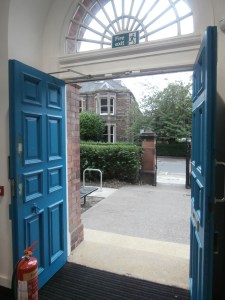My very first visit to the theatre as a child was to see ‘Peter Pan’. I don’t remember much about the show, but vividly recall being up on high looking down at a stage and being entranced by a very large dog (Nana) each time it appeared. Most of all I remember being mesmerised by Tinker Bell. The magic, the darting light, the tinkling laughter. ‘When the first baby laughed for the first time’, wrote J M Barrie, ‘its laugh broke into a thousand pieces, and they all went skipping about, and that was the beginning of fairies.” Oh yes, I believe in fairies. I believe in Angels too. Spiritual ones with the wings and also the ones without who walk in our midst on a day-to-day basis. I’m sure you know Frank Capra’s film ‘It’s A Wonderful Life’ in which Clarence, the angel, earns his wings. It is via this warm- hearted character that George Bailey learns the fact that no man is an island: “Strange, isn’t it? Each man’s life touches so many other lives. When he isn’t around, he leaves an awful hole.” And also the value of friendship: “Remember, George: no man is a failure who has friends.” Sometimes we need to be reminded about both of these things because, in the busyness of the world around us today, it is very easy to forget. Did you hear a bell ping at the end of the renovation process way back in September 2016? Well that was Giuseppe earning his wings via me.

I miss Giuseppe. We saw him about the building for quite a while into the new term, as the snagging process seemed to be endless. It was always a boost to see his smiling face, but he eventually moved on to a new job – a very prestigious one at that – on Lord Lambton’s estate. It was very fitting, I thought, that the care he had taken to preserve as much of our Old Building’s heritage as possible – in particular the architectural photographs he had taken for this blog – helped him put together the portfolio which secured him the job. On the day we took these photos, Giuseppe’s wife had just given birth to a baby girl whom he hoped might one day attend this very school. After he’d gone, I took some shots of the office he had worked from whilst onsite, high up in the eaves at the top of Westward House. There is no doubt that from here he had a splendid view of School.



 I know a lot more about the story of Peter Pan now. It isn’t all child’s play and sparkle-dust. Peter is, after all, a ‘Lost Boy’ and when we first meet him we learn that has been totally disconnected from his own shadow. I can identify with that. And also his determination to become re-connected with it. Peter’s quest could almost be a metaphor for the creation of my blog. I felt cast-adrift and severed from my own legacy for a long while after the merger. But I found a way back. I have always thought – and taught – in metaphors, a method of analogy which has worked for many of my students over the years. I hope it’s working for you here. Pictures can help a lot too. In visual terms, our trajectory has taken us from here to here:
I know a lot more about the story of Peter Pan now. It isn’t all child’s play and sparkle-dust. Peter is, after all, a ‘Lost Boy’ and when we first meet him we learn that has been totally disconnected from his own shadow. I can identify with that. And also his determination to become re-connected with it. Peter’s quest could almost be a metaphor for the creation of my blog. I felt cast-adrift and severed from my own legacy for a long while after the merger. But I found a way back. I have always thought – and taught – in metaphors, a method of analogy which has worked for many of my students over the years. I hope it’s working for you here. Pictures can help a lot too. In visual terms, our trajectory has taken us from here to here:




Of course, how we finally got to the position of re-opening Newcastle High School on Tankerville soil wasn’t as simple as these images might suggest in ‘real-time’ at human grass-roots level. Real life never is. However, in February 2018 the working partnership of Ellis Williams Architects and Wates Construction on Tankerville Terrace was recognised as an exemplar of architecture and environmental design at Newcastle City Council’s 2018 Lord Mayor’s Design Awards. These awards are held every two years to encourage, promote and publicise the best in architecture and environmental design in the North East with a view to improving the built-up environment for all. Whilst the Tankerville site only achieved Commended Finalist status in the New Building category – the judges describing the rebuild as “an ambitious school project providing modern facilities in a sensitive manner within the conservation area” – the site renovation project as a whole won the Lord Mayor’s Special Award. The Lord Mayor of Newcastle, Councillor Linda Wright, was “particularly impressed with the investment in the education of the city’s children demonstrated by the scheme. The combination of works to the existing school and the addition of the exciting new building has created a new learning environment whilst maintaining an historic link with the school’s past.” Prior to taking up the Lord Mayor’s office, a role Linda’s mother had held before her, Councillor Linda Wright was also present at the unveiling of the Zoe Robinson’s seahorse statue in May 2017.

In human terms, however, disorientated and unsighted having been left ‘dumped into the long grass’ (to borrow a helpful analogy from Laurie Lee’s ‘Cider With Rosie’), metaphorical thinking was all there was to sustain us, metaphors being the tool human beings have used to explain the seemingly unexplainable since ancient times. Some things, it turns out, are just too complex to conform to the unifying order of a string of inter-connected words. And as the American novelist, Orson Scott Card, understood very well: “Metaphors have a way of holding the most truth in the least space.” Extended metaphors even more so. I’d watched the opening of the Ark in ‘Raiders of the Lost Ark’ while Indiana Jones was tied to a post with his eyes tight shut. Knew of Karen Blixen’s hard-won truths in ‘Out of Africa’: “You know you are truly alive when you’re living among lions.”; “The Earth was made round so that we would not see too far down the road.”

If I were to use the tale of Peter Pan again to convey the dark places along the way as the building and I travelled from the old to the new, the crocodile comes immediately to mind. But as I set out on my quest for truth to conquer all, there wasn’t the luxury of knowing that my metaphorical crocodile had once swallowed a ticking clock. At such times, one is grateful for the angels that cross your path. Which brings me back to Giuseppe and the legacy he left behind. He will now be forever connected in my mind with the Little Bell Tower.

I now know the structure isn’t a bell tower, of course, but the phrase ‘Little Green Boyle’s Ventilator’ doesn’t quite have the same ring to it. As this blog moves on to focus solely on Church High Heritage now that the story of the Tankerville site transformation is done, you will hear a lot more about the School and its building as it was. Suffice to say here that the sub-divided classroom (in height), which we knew in recent times as Room 8, was originally designed as a Science Laboratory – in the days when such things were rare indeed.




 I didn’t talk to Giuseppe again about the ‘Little Bell Tower’ but, as the end of the project was nearing, something Conal said in passing made me smile. As the teal gloss was being applied to the external doors, I recall asking him if all the wood was going to be teal. He said he thought so, but then took back his words, nodding at ‘the bit on the roof’ they had previously painted teal but had been made to repaint. Giuseppe’s orders, he said. On site, the Clerk of Work’s word is final. It wasn’t until I downloaded a batch of Giuseppe’s photographs a little later on that the full force of what Conal had meant emerged. I did tell you that Giuseppe was a stickler for detail and Tankerville is a conservation area after all. A picture is worth a thousand words they say, so I will stay quiet here and leave it to Giuseppe himself to show you his legacy gift in a little photo story.
I didn’t talk to Giuseppe again about the ‘Little Bell Tower’ but, as the end of the project was nearing, something Conal said in passing made me smile. As the teal gloss was being applied to the external doors, I recall asking him if all the wood was going to be teal. He said he thought so, but then took back his words, nodding at ‘the bit on the roof’ they had previously painted teal but had been made to repaint. Giuseppe’s orders, he said. On site, the Clerk of Work’s word is final. It wasn’t until I downloaded a batch of Giuseppe’s photographs a little later on that the full force of what Conal had meant emerged. I did tell you that Giuseppe was a stickler for detail and Tankerville is a conservation area after all. A picture is worth a thousand words they say, so I will stay quiet here and leave it to Giuseppe himself to show you his legacy gift in a little photo story.




 A very small ‘victory’ it may have been, but, nevertheless, all those folk who said that everything would change and that nothing would ever be the same again on Tankerville were not completely right. Did I know this would be the case? Of course not. But I had hope. And I believe in Angels. I also know that rainbows follow the rain.
A very small ‘victory’ it may have been, but, nevertheless, all those folk who said that everything would change and that nothing would ever be the same again on Tankerville were not completely right. Did I know this would be the case? Of course not. But I had hope. And I believe in Angels. I also know that rainbows follow the rain.

It’s not the same, of course. The building doesn’t have the same feel or spirit and I try to avoid going into the old Hall and the LRC, but it’s still more identifiably Church High than was no doubt ever the intention. Early in the first term back on Tankerville, I passed a lady being shown around the Old Building and as the pair moved on I heard her say “Your legacy isn’t anywhere near as obvious as I thought it was going to be …” Out of the corner of my eye I saw the guide glance my way and felt the tailing off followed by a silence. I beg to differ, of course. Because a legacy cannot be just glossed over, obliterated forever by a coat of white paint and the installation of huge expanses of glass. It’s a lot more prevailing than that. It just takes one person to still remember and Church High was not the kind of place people forget. My mother once gave me a praying hands necklace with the Serenity Prayer on the reverse: ‘Dear God, give me the Grace to accept the things that cannot be changed, the Courage to change the things which should be changed, and the Wisdom to distinguish the one from the other’. Without ever learning it, I’ve never forgotten that prayer and, come merger time, what I could do was conserve the history. Like all the girls who walked out into the world through the green front door, in true Church High fashion I used the Voice I was given. If Giuseppe’s legacy is the ventilator, then mine is this blog. And as with Joe Armstrong before us, our names are now a part of the building, there to be discovered by someone like me, somewhere in the future, who might take the time to muse, “I wonder who they were? And what part did they play?”


With all the metaphorical dust now settled, it surprises even me just how much green there is still dotted around the Tankerville site. And that’s not even counting the green of the grass and trees. Little did one know, awash with waves of sadness as skips were filled, that four years on the Old Girl would still be green from her head to feet.



It’s all down to the angle you choose to look at things, I guess. Which is how the new glass can’t help but look green when looked at slant.
The elemental hue of Life, green is a very hard colour to eliminate should you be that way inclined. As it takes up more space in the spectrum visible to the human eye, green will dominate any scene.

The July we left Eskdale, I gave Hilary a present of one of my ‘wise little’ books, Kate DiCamillo’s ‘Because of Winn Dixie.’ Its back jacket blurb ends with the line ‘just about everything that happens that summer is because of Winn Dixie’. Hilary appreciated why I’d given it to her. Understood the implied analogy. Yes, a lot of things have happened ‘because of the merger’. A lot. It’s not a ride I would have opted to take in a million years and it’s important to remember it was difficult for us all. The ultimate winner is history. Owing to the merger, the Jesmond landscape has already changed once and there will be even bigger changes to it very soon. Yes, we should all pay more attention to history. Winn Dixie’s final line is ‘And I listened careful, so I could learn it right.’ A lesson I hope now learned by all.

So where do we go from here? Well, as a good friend of mine, Peter Sarah (General Manager of Theatre Royal, R.I.P.) often used to say: ‘Onwards and Upwards’. Because that is the only way. Always. All things green eventually find the light and grow towards it. And if you would care to join me, we take our bearings from the second star to the right. From there, I promise you, it is straight on until morning.


































































































